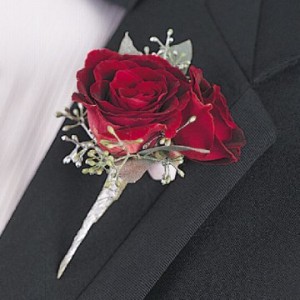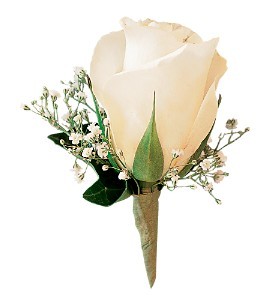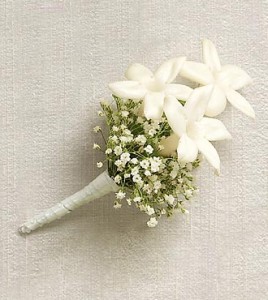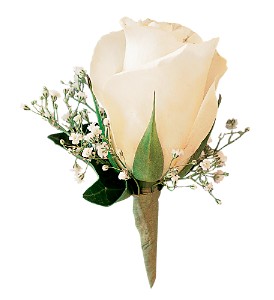The idea of ladies using flowers to adorn themselves is a commonplace concept for most. However, gentlemen can use a bit of flora as well. Not just for weddings, using a boutonnière can create a debonair and gallant look when added to the right suit.
What exactly is a boutonnière?
 Simple put, a boutonnière is a single or small arrangement of flowers worn on a man’s jacket. Typically it is seen on the lapel or over over the heart. They can be comprised of either silk or real flowers, though typically they tend to be fresh and fragrant. Florists can create custom boutonnières for special occasions that are typically pinned on, or they can be as simple as a single flower tucked into the breast pocket. The type of flower or flowers used can be as varied as the wearers, though large flowers can become cumbersome to most and are generally avoided. In some cultures, particularly at weddings, the men will wear large garlands of flowers as symbolic decoration.
Simple put, a boutonnière is a single or small arrangement of flowers worn on a man’s jacket. Typically it is seen on the lapel or over over the heart. They can be comprised of either silk or real flowers, though typically they tend to be fresh and fragrant. Florists can create custom boutonnières for special occasions that are typically pinned on, or they can be as simple as a single flower tucked into the breast pocket. The type of flower or flowers used can be as varied as the wearers, though large flowers can become cumbersome to most and are generally avoided. In some cultures, particularly at weddings, the men will wear large garlands of flowers as symbolic decoration.
Where did boutonnières come from?
 The practice of men adorning themselves with a single flower or a small bundle of them dates back as far as the middle-ages, if not possibly further. In those times it was not referred to as a boutonnière, instead it was a token of chivalry worn by a knight or lord when going into battle, either on the field or in the jousting lists. The flower, or other items such as a scarf or ribbon, was of a colour that represented his lady love.
The practice of men adorning themselves with a single flower or a small bundle of them dates back as far as the middle-ages, if not possibly further. In those times it was not referred to as a boutonnière, instead it was a token of chivalry worn by a knight or lord when going into battle, either on the field or in the jousting lists. The flower, or other items such as a scarf or ribbon, was of a colour that represented his lady love.
The tradition continued over time and the meaning was adapted in different countries. Boutonnières, or “button hole flowers” as the term means can be noted in French paintings from the 16th century, though the trend was sensationalized by the English. The boutonnière become even more popular during the Victorian times when flowers were used to secretly express emotions that were otherwise forbidden conversations.
Boutonnières in more modern times.
 The secret meanings, though, became less important as times changed and the simple boutonnière became more of a status symbol for classy gentlemen. Actors in the early 1900s wore them as a means to set the standard in appearance. Some, like Cary Grant, still kept their flower choice as symbolic. He wore a single red carnation that stands for royalty in his birth country of the United Kingdom. Though, the simplistic use of a single flower on a man’s lapel or over his breast pocket was a gentleman’s daily trend up through the 60s.
The secret meanings, though, became less important as times changed and the simple boutonnière became more of a status symbol for classy gentlemen. Actors in the early 1900s wore them as a means to set the standard in appearance. Some, like Cary Grant, still kept their flower choice as symbolic. He wore a single red carnation that stands for royalty in his birth country of the United Kingdom. Though, the simplistic use of a single flower on a man’s lapel or over his breast pocket was a gentleman’s daily trend up through the 60s.
Its popularity dwindled and the use of them is not as common in everyday life like it had been. Fewer men wear daily boutonnières, most tend to reserve their use for special occasions, such as proms and weddings. It is no longer considered part of normal business attire, whereas the silk handkerchief in the pocket seems to of replaced the colourful floral accessory. Despite its falling out of popularity, it will always add a debonair touch to any man’s attire.

Comments